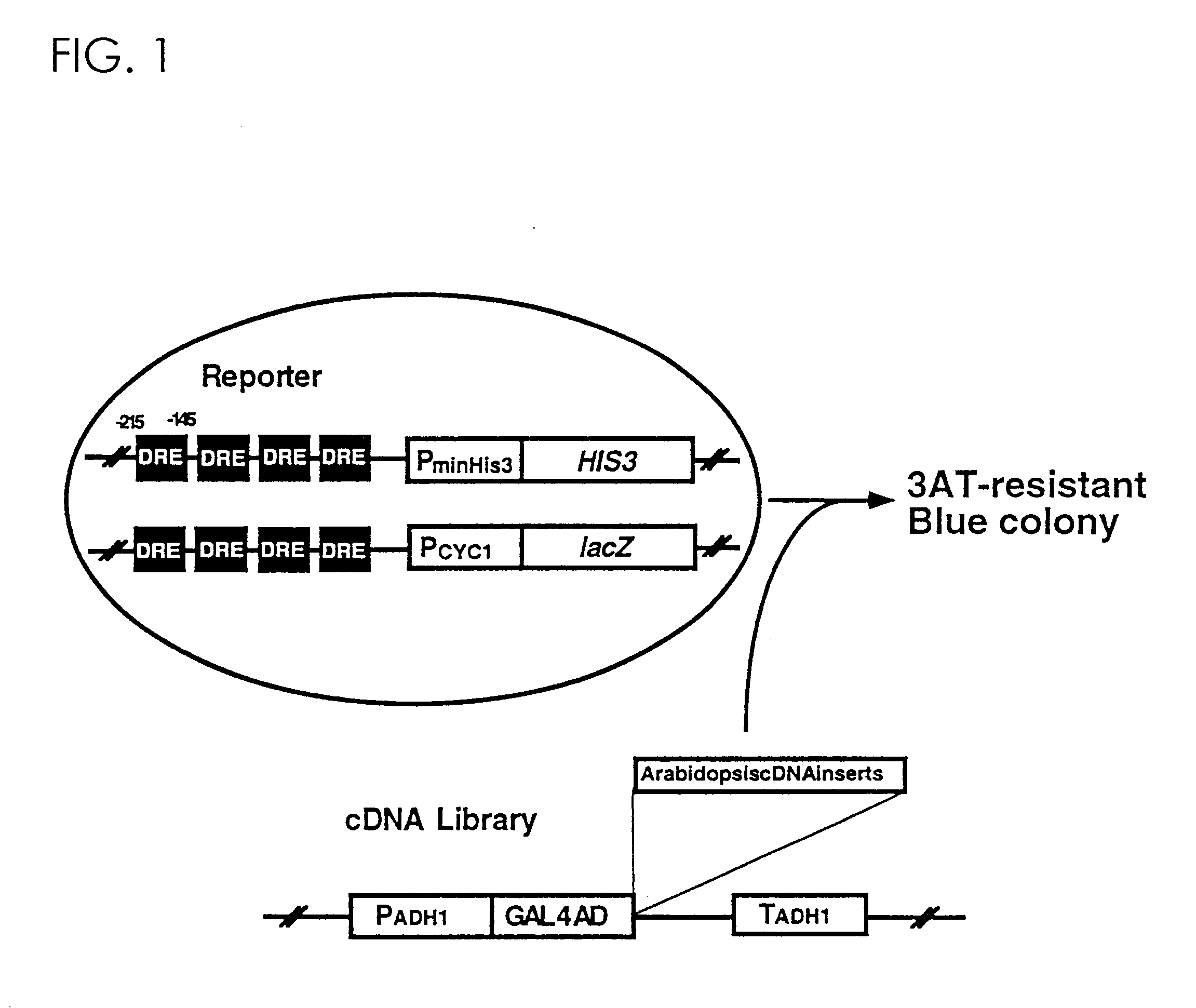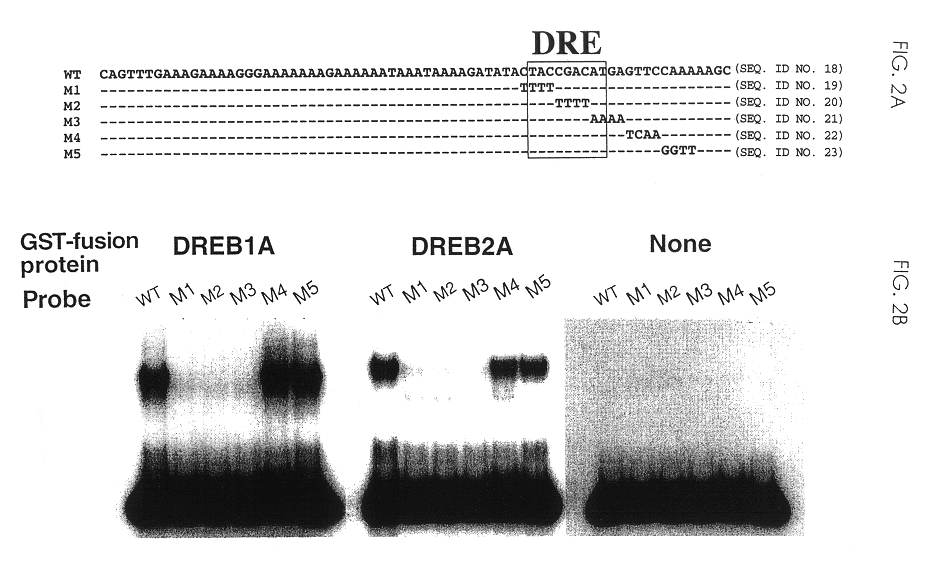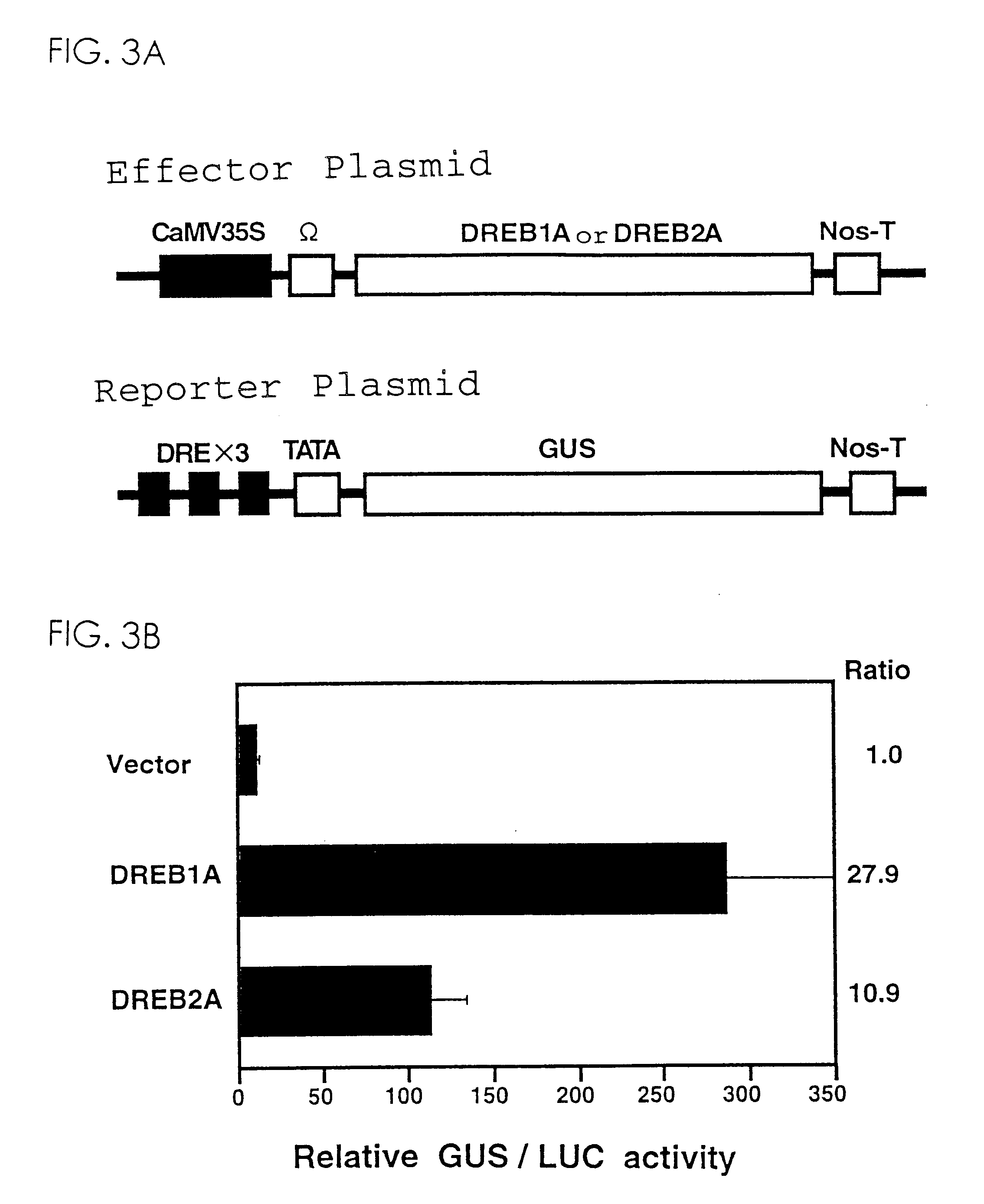Environmental stress-tolerant plants
a technology of environmental stress and plants, applied in the field of transgenic plants, can solve the problems of long time, low temperature injury, and plant inability to protect themselves from stress by moving, and achieve the effect of improving tolerance to environmental stress and free from dwarfing
- Summary
- Abstract
- Description
- Claims
- Application Information
AI Technical Summary
Benefits of technology
Problems solved by technology
Method used
Image
Examples
example 1
Cloning of DREB1A Gene and DREB2A Gene
(1) Cultivation of Arabidopsis thaliana Plant
Arabidopsis thaliana seeds obtained from LEHLE SEEDS were sterilized in a solution containing 1% sodium hypochlorite and 0.02% Triton X-100 for 15 min. After rinsing with sterilized water, 40-120 seeds were sown on GM agar medium [4.6 g / L mixed salts for Murashige-Skoog medium (Nihon Pharmaceutical Co., Ltd.), 0.5 g / L MES, 30 g / L sucrose, 8 g / L agar, pH 5.7] and cultured at 22.degree. C. under conditions of 16 hr light (about 1000 lux) 8 hr dark, to thereby obtain plant.
(2) Preparation of Poly(A).sup.+ RNA
The plant bodies obtained in (1) above were subjected to low temperature treatment at 4.degree. C. for 24 hr, and then total RNA was prepared from them by the glyoxal method. Briefly, 3 g of Arabidopsis thaliana plant frozen in liquid nitrogen was suspended in 100 ml of 5.5 M GTC solution (5.5 M guanidine thiocyanate, 25 mM sodium citrate, 0.5% sodium N-lauroyl sarcosinate) and solubilized quickly wi...
example 2
Analysis of the DRE-Binding Ability of DREB1A and DREB2A Proteins
The ability of DREB1A and DREB2A proteins to bind to DRE was analyzed by preparing a fusion protein composed of glutathione-S-transferase (GST) and DREB1A or DREB2A protein using E. coli and then performing a gel shift assay. Briefly, the 429 bp DNA fragment from position 119 to position 547 of the nucleotide sequence of DREB1A cDNA or the 500 bp DNA fragment from position 167 to position 666 of the nucleotide sequence of DREB2A cDNA was amplified by PCR. Then, the amplified fragment was ligated to the EcoRI-SalI site of plasmid pGEX-4T-1 (Pharmacia). After the introduction of this plasmid into E. coli JM109, the resultant transformant was cultured in 200 ml of 2.times.YT medium (Molecular Cloning, (1982) Cold Spring Harbor Laboratory Press). To this culture, 1 mM isopropyl .beta.-D-thiogalactoside which activates the promoter in plasmid pGEX-4T-1 was added to thereby induce the synthesis of a fusion protein of DREB1A ...
example 3
Analysis of the Ability of DREB1A and DREB2A Proteins to Activate the Transcription of Genes Located Downstream of DRE
In order to examine whether DREB1A and DREB2A proteins are able to trans-activate DRE-dependent transcription in plant cells, a trans-activation experiment was conducted using a protoplast system prepared from Arabidopsis thaliana leaves. Briefly, the cDNA of DREB1A or DREB2A was ligated to a pBI221 plasmid containing CaMV35S promoter to thereby construct an effector plasmid. On the other hand, 3 cassettes of the DRE-containing 71 bp DNA region were connected tandemly to prepare a DNA fragment, which was then ligated upstream to the minimum TATA promoter located upstream of .beta.-glucuronidase (GUS) gene in a plasmid derived from pBI221 plasmid to construct a reporter plasmid. Subsequently, these two plasmids were introduced into protoplasts from Arabidopsis thaliana and then GUS activity was determined. When DREB1A or DREB2A protein was expressed simultaneously, GU...
PUM
| Property | Measurement | Unit |
|---|---|---|
| temperature | aaaaa | aaaaa |
| temperature | aaaaa | aaaaa |
| temperature | aaaaa | aaaaa |
Abstract
Description
Claims
Application Information
 Login to View More
Login to View More - R&D
- Intellectual Property
- Life Sciences
- Materials
- Tech Scout
- Unparalleled Data Quality
- Higher Quality Content
- 60% Fewer Hallucinations
Browse by: Latest US Patents, China's latest patents, Technical Efficacy Thesaurus, Application Domain, Technology Topic, Popular Technical Reports.
© 2025 PatSnap. All rights reserved.Legal|Privacy policy|Modern Slavery Act Transparency Statement|Sitemap|About US| Contact US: help@patsnap.com



